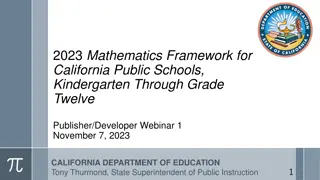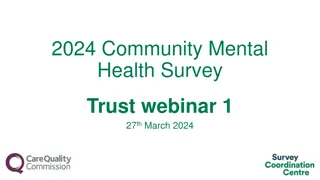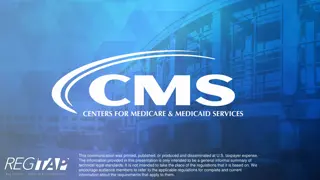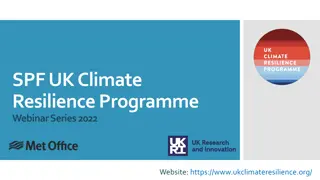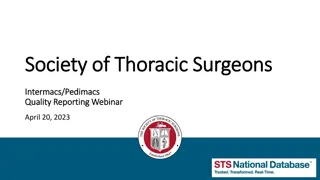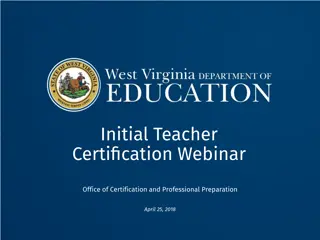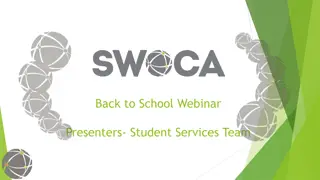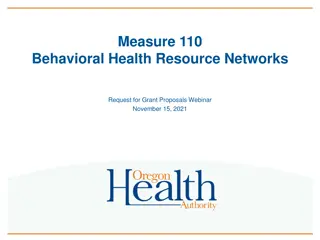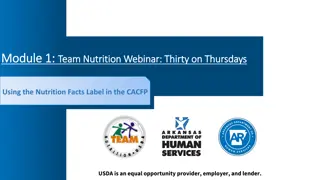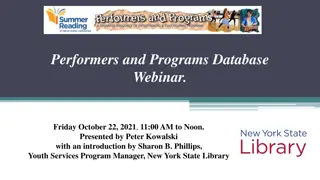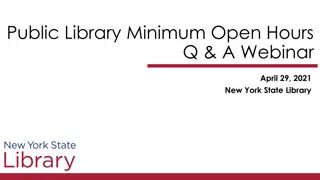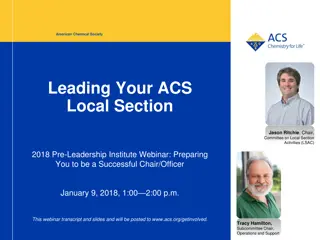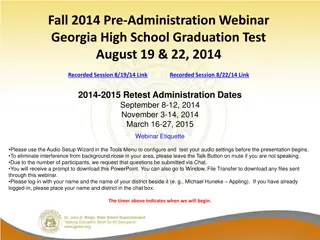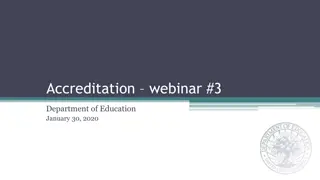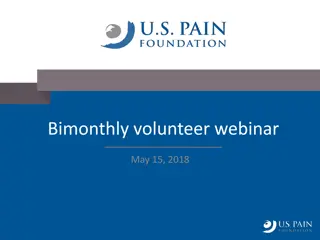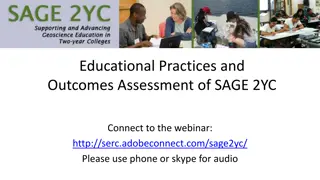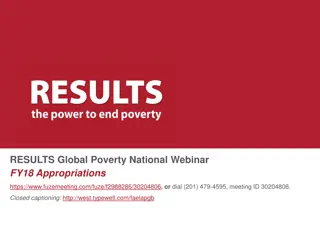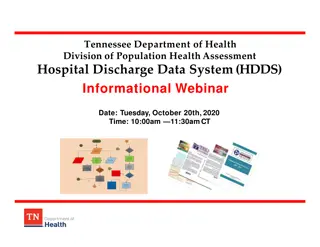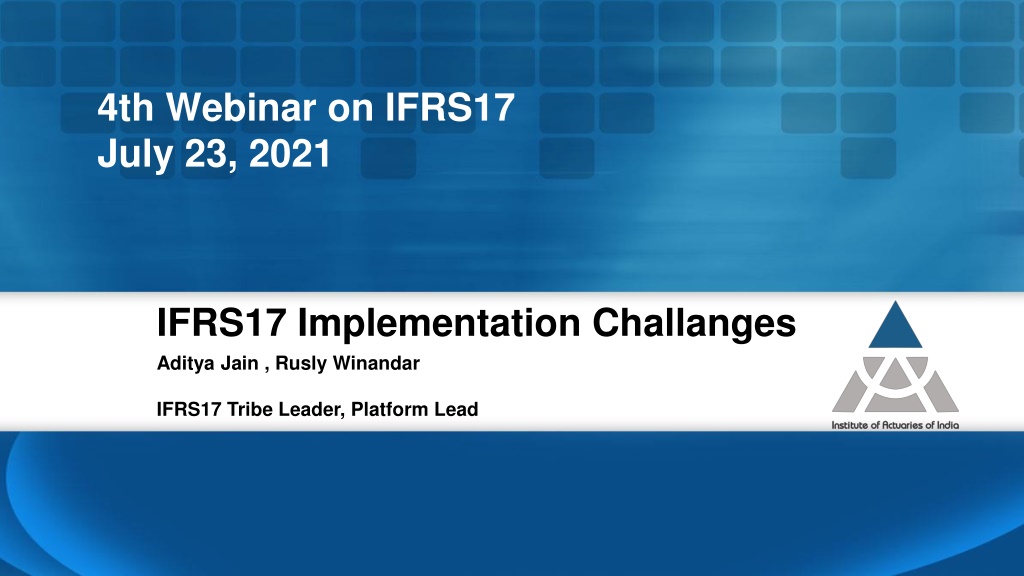
Key Challenges and Solutions in Implementing IFRS17
This content discusses the key challenges and solutions in implementing IFRS17, focusing on technical interpretation, impact assessment, transition challenges, and more. It emphasizes the importance of baselining standard interpretations, performing impact assessments, and addressing transition hurdles such as data availability and past year accounting treatments. The need for alignment with regional partners, stakeholder approvals, and customized business requirements is highlighted throughout the discussion.
Download Presentation

Please find below an Image/Link to download the presentation.
The content on the website is provided AS IS for your information and personal use only. It may not be sold, licensed, or shared on other websites without obtaining consent from the author. If you encounter any issues during the download, it is possible that the publisher has removed the file from their server.
You are allowed to download the files provided on this website for personal or commercial use, subject to the condition that they are used lawfully. All files are the property of their respective owners.
The content on the website is provided AS IS for your information and personal use only. It may not be sold, licensed, or shared on other websites without obtaining consent from the author.
E N D
Presentation Transcript
4th Webinar on IFRS17 July 23, 2021 IFRS17 Implementation Challanges Aditya Jain , Rusly Winandar IFRS17 Tribe Leader, Platform Lead
Agenda Technical Transition Solution Implementation www.actuariesindia.org
Technical Paper Interpretation Baselining standard interpretation before designing solution and get key stakeholder (like senior management, auditors) approvals Working in Agile model where implementation can start based on baselined standard interpretation Align as much as possible with your regional partner to avoid dual accounting With technical interpretation perform technical assessment or test your interpretation and alternatives using Impact Assessment Most of the time we took to deliberate the interpretation paper were VFA eligibility Coverage units Discount Rates Level of aggregation Onerous contracts Determining the Key Performance Indicators Transition Approach www.actuariesindia.org
Performing Impact Assessment Impact Assessment result helps us understand the levers It tells us which transition approach we should take It also tells us what simplification is required in solution Gives a high-level indication of our opening CSM and Shareholder equity www.actuariesindia.org
Agenda Technical Transition Solution Implementation www.actuariesindia.org
Transition Challenges : Functional Availability of Past Data Use of hind sights and doing the right thing Availability of data (completeness and granularity) Why and when to use FRA and FVA Use of multi model or one model approach for Actuarial models/ actuarial data availability / ability to perform analysis of movement One should consider using MRA approach since it can give significant uplift How do you calculate risk adjustment for past year? (especially in periods when you did not have ECAP) Extraction and Reconciliation How to allocate expenses, how to make sure chart of accounts reconcile? Issues on VFA cashflows such as FMC not stored at policy level Business requirements need to be customized for each year How to perform onerous cohort classifications Past year data not easily available/ not granular enough Accounting treatments in different years: manual adjustments, use unmodelled cashflows
Transition Challenges : Technology Define and document clear business requirements. Must conduct data gap assessment including data from manual processes. Can start from impact assessment. Start early. Different level of data granularity (policy, product group, cohort) Data How do we procure historic data both transactions and snapshot (data restore might be time consuming with infrastructure constraints)? Consider data availability and granularity to decide on transition approach. Ensure enhancements in source systems do not impact historic data. Use the same data source used for previous years reporting. Depending on approach taken, tools to be customized for each year Consider data gap assessment result (availability and granularity) to decide which transition approach to use in which years and build the process to extract and transform those data. How to build standard process to address various changes over the years? Such as changes in valuation data, accounting data methodology, different data format and fields Process Plan to build different transition approaches in transition tools. How do we procure data from manual processes, such as claims from third party administrators and reinsurance data that were not standardized? Plan to collect historic data from manual processes and load the data into database for further data transformation. Evaluate and select platform and tools that are aligned with company s technology architecture and with available resources in the market. Example: Informatica, Talend, IBM InfoSphere, Microsoft SSIS, etc. Technology What database platform and data transformation tools to use? How to ensure enough capacity for all transition data and to run transition tools for many years (storage, processing power, network to retrieve data from source systems to transition database)? Consider using cloud-based infrastructure: Azure, Google, AWS, etc. (faster provisioning, pay based on usage, can increase capacity as needed). Based on data gap assessment, might need to setup infrastructure for restoration of backup data, need to weigh cost and benefits.
Transition Challenges : Testing Scope and Approach Planning Test Findings Plan to include effort and time to: Run Transition tools for many months (depending on scope) Collect historical data from all data sources (systems, Excel, text / csv files) Clean up and standardize historical data (could be different data format, incorrect data, or ad-hoc data changes) Implement changes from Solution and re-run Transition tools if needed Investigate issues found during testing Many reconciliation issues during testing -> use baseline data and group output data in various combinations to identify and isolate the difference, deep-dive into detailed data Define clear scope for each tests (unit test, system test, system integration test, user acceptance test) Agree on what will and will not be tested Some possible findings: Data patching to fix issued in the past Manual adjustments on accounting ledger or policy admin systems Data quality issues in policy admin systems Transition tools does not use correct logic to process some past transactions (the transactions rarely happens, it did not happen in recent years, or there were enhancements in source systems) Ad-hoc / temporary business initiative in the past (such as one-off compensation program, special customer program, etc.) Perform testing in cycles, start with 1 month production data for each type of transition approach, then extend to full year Perform data gap assessment for historical data Involve subject matter expert from technology team who has very good knowledge of the source systems in data gap assessment Implement testing automation and include data quality checks to verify data input and output Prepare baseline data for comparison with Transition tools output (such as current reports) Establish team that has technical and business knowledge and include functional and technology subject matter experts, including data engineer skill sets
Agenda Technical Transition Solution Implementation www.actuariesindia.org
Solution : Actuarial Challenges Data and Model Changes in order to meet IFRS17 specific requirements Solution will require policy level results to be produced for Base step and AOM steps Processing and Storage concerns Needs to optimize the model run time and impact on Work Day Timetable Modelling of Reinsurance treaties including multiple treaties for same contract Solution Design may change as there is change in technical interpretation how to ensure consistency across design / how to fit the testing of these changes in SIT/UAT to meet the target timeline Unmodelled products or cashflows significant burden on process to produce consistent results Some of the accounting manual adjustments will now need to flow
Solution : Accounting Challenges Create a independent accounting ledger or use current ledger and add adjustment ledger to produce IFRS17 results Data availability, granularity and transformation One to One mapping required between Chart of Accounts of current reporting and IFRS17 reporting to help reconciliation Impact on BAU Complicated Expense allocation drivers to ensure group of contracts do not become onerous ; alignment with current experience investigation process Alignment of definitions between actuaries and accounting to ensure unnecessary variances are not created impact on CSM and current profitability Allow for some approximation/simplifications no marks for spurious accuracy Manual Journal entries which require high level of assessment to allow for proper handling in IFRS17
Solution : Technology Challenges Define and document clear business requirements. Do we have all the required data at the right level of granularity? How do we extract those data for data transformation in the solution? Conduct data gap assessment, can leverage and expand from Transition. Data Identify all data sources and design data model and flow. What enhancements are required in source systems to provide the data? Design and build source system enhancements to provide the data. How do we ensure data consistency between data sets used for current and IFRS 17 reports? Design and build solution to extract and ingest data from all data sources. Chart of accounts mapping and reconciliation with current reporting. Design process to meet work-day timetable for financial reporting, factoring all systems and manual processes that provide the data input. Include un-happy scenarios in design of to-be process. How to design future process can meet work-day timetable? Process How do we procure data from manual processes on time? Identify opportunities for automation. Consider investment to build automated solution to replace Excel files for large data transformation. For example: expense allocation, claims data from third party administrators. How to design future process that can handle un-happy scenarios (data issues from source systems, issues during extraction, etc.)? Evaluate and select platform and tools aligned with company s technology architecture and with available resources in the market. Use same tools as in Transition. Example: Informatica, Talend, IBM InfoSphere, Microsoft SSIS, etc. Technology What database platform and data transformation tools to use? Consider using cloud-based infrastructure: Azure, Google, AWS, etc. (faster provisioning, pay based on usage, can increase capacity as needed). How to design infrastructure with enough capacity to run data transformation and store data in the future? Good opportunity to review and design data architecture for future. Implement data quality checks in the solution.
Solution : Technology Challenges Scope and Approach Test Preparation Test Findings Prepare positive and negative test cases Data format issues > mitigate with data quality checks in the solution design and test scripts Define clear scope for each tests (unit test, system test, system integration test, user acceptance test, performance test, etc.) Build test data preparation tools to create mock-up test data: Inconsistent data between solution components > mitigate with data quality checks and include those test cases in system integration test and user acceptance test Agree on what will and will not be tested To test smaller data sets To test future business events that are not available in current data sets Perform testing in cycles, start with mock-up test data, before full volume production data Data for some expected cashflow are not available -> create mock-up data if data are not available in source systems Implement testing automation and include data quality checks in test scripts to verify data input and output Must decide on materiality of errors that is acceptable in test results Test consistency across solution design (expected and actual cash flow) using same parameters Review test data before testing starts Data extraction from source systems does not meet the expected work-day timetable -> fine tuning and optimization Store transition data into database in standardized format for trend analysis on reasonable check Test processes and controls including work-day timetable Prepare and update test scripts and test automation while solution is being built Test result vs reported metrics How to test subledger Perform regression testing whenever there is change in the solution
Agenda Technical Transition Solution Implementation www.actuariesindia.org
What will help successful implementation Approach the implementation as technology project, not only Actuary and Accounting project Strong project management is required, deliver incrementally and iteratively Manage budget and spending (implementation will take > 12 months) Prioritize spending (good to have vs must have), unique situation for each company Establish governance structure and process for decision making and managing delivery Establish process to incorporate changes in business-as-usual to this project Project Delivery Plan and structure the team (Actuary, Accounting, Technology resources) Accept that we are unable to get experienced IFRS17 resources in market and need to train them Plan for training early on and throughout project (including on-job-training) Have good mix of resources: BAU and new staffs + consultants / contractors Build cross functional team and team should have cross-functional knowledge Resources Scope of solution includes end-to-end process from data sources, transformation, and reporting Need to design and test processes and controls for running the solution Solution to be designed to meet work-day timetable requirement Dependency on process improvement, such as finance process transformation Plan and execute multiple testing phases to mitigate risks (unit test, system test, system integration test, user acceptance test, performance test) Solution
Questions www.actuariesindia.org


